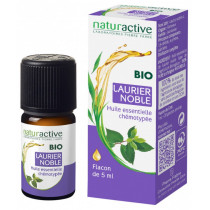Indications of organic noble laurel essential oil
Treats digestive problems (antispasmodic & anti-septic essential oil), used for benign bronchial infections (anti-septic & mucous-flow essential oil).
Botany information
Laurus nobilis Botanical family: Lauraceae Producing organ: branch Chemotype: 1.8 cineole, alpha-pinene, sabinene, linalool, eugenol Origin: Croatia, Albania, Hungary
Botany specifications
It is with these branches that the Romans crowned their heroes. This small evergreen Mediterranean tree is also known as “sweet bay” due to its lanceolate leaves perfectly flavouring stew dishes.
Use
Diffusion ++, Bath +, Massage ++, Orally +++
Ambient setting: on its own or in a mixture by regular low heat evaporation.
Atmospheric diffusion: not recommended (unpleasant odour)
Dermal application: diluting 5% maximum in vegetable oil.
Orally: mixed with other essential oils, exceptional use, only with medical consent. 1-2 drops per day.
Inhalation: not recommended
Practical advice
Intestinal problems : In case of gastro-intestinal problems among adults: in a 30ml bottle, mix 30 drops of noble laurel EO + 60 drops of French basil EO finished with a vegetable oil (macadamia). Apply onto the abdomen 2-3 times per day.
Treating coughs : In the case of bronchial blockage or inflammation (for adults): in a 30ml bottle mix 30 drops of noble laurel EO + 60 drops of red myrtle EO finished with a vegetable oil. Apply onto the thorax 2 to 3 times a day. In case of persistent coughing, consult your doctor.
Contraindication
Contains eucalyptol. Not recommended for pregnant or breast feeding women or children under 8 years of age.




